Vegan Jajangmyeon (자장면) is a Korean noodle dish, also spelled with two J’s as in Jjajangmyeon. The dramatic black colour comes from a fermented black bean paste called chunjang, which gives these noodles a uniquely sweet and savoury flavour.
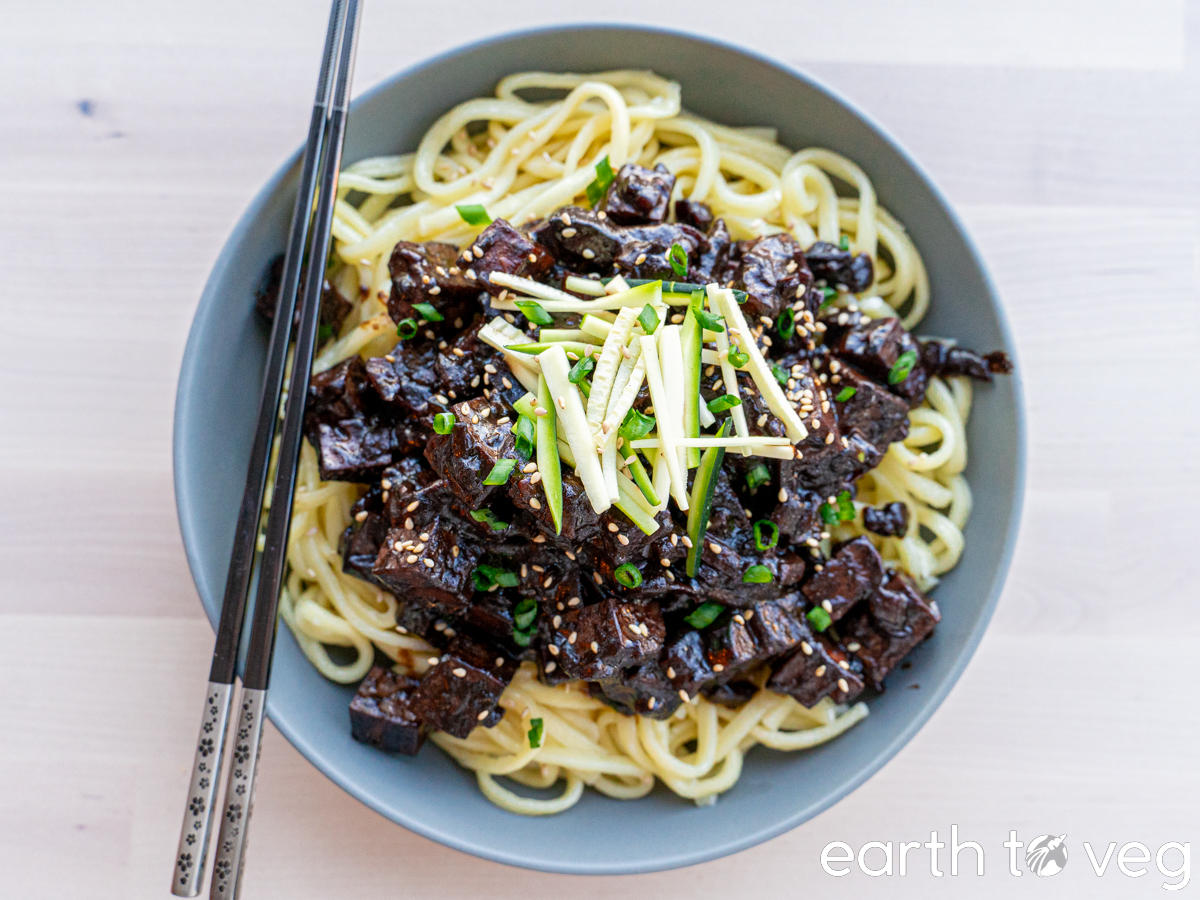
Maybe the irony of this recipe is that it makes two servings when one serving would be more apropos. In Korea, there is a holiday every April 14th called Black Day, an anti-Valentine’s day dedicated to all the lonely singles out there. Tradition calls for single people to commiserate and eat inky black jjajangmyeon together. So when you make jajangmyeon, save a bowl for a bachelor/bachelorette in your life… or, hey, keep it for yourself for the next day. No judgement.
What You’ll Need
Here are the ingredients for vegan jjajangmyeon:
Noodles
I prefer using fresh or frozen noodles, because they have the best texture—thick and super chewy. Korean grocery stores sell noodles specifically for jjajangmyeon; look for the words 우동 짜장면 or 중화면. Japanese udon noodles are a little thicker than the noodles traditionally used, but they also work well. Dried jjajang noodles are okay or even pasta as a last resort; choose something like linguine or another noodle of similar thickness.


Did you know? Jjajang sauce can be eaten with rice instead of noodles—this is called jjajangbap. Same sauce, different carb. So feel free to swap out the noodles in this recipe for Steamed Rice!
Jjajang Sauce Ingredients

Notes on some of the important ingredients in this recipe:
Oil: Use a neutral-flavoured cooking oil, like grapeseed, sunflower seed, or canola. If you don’t have an allergy to it, peanut oil is also a good one. It adds a subtle nutty flavour that’s really good!
Tofu, any kind of tofu! (As long as it’s somewhat firm.) My favourite to use for this recipe is smoked tofu. But fried tofu, firm tofu, pressed beancurd, whatever, they’re all A-OK.
Zucchini, daikon radish, potato: You can use a mix of all three of these ingredients, or just one or two. (Don’t do all daikon radish, though; the flavour is too strong.)
Dried shiitake mushrooms should be soaked for at least two hours. Adds some delicious umami flavour.
Chunjang paste gives jjajangmyeon its signature black colour and its unique flavour. Made of fermented black beans, this ingredient can be found at any Korean grocery store, or ordered online. Note that different brands of chunjang paste have varying degrees of saltiness, so you may have to add a dash more salt at the end of cooking if you find that your chunjang paste is not as salty.
Water: Save and use the mushroom-soaking water for max flavour.
Cornstarch thickens the sauce. Can also be substituted with potato starch or tapioca starch.
Sesame oil: Like olive oil, sesame oil loses its flavour when exposed to heat. So mix this in at the last minute (just a tiny drizzle will do).
For a full list of ingredients and quantities, refer to the recipe card at the bottom of this post.
Step-by-Step Process
Start by making the jajang sauce:
Jjajang Sauce

Step 1: Heat a wok or sauté pan on medium heat and add 1 tbsp of oil. (Reserve the remaining 1/2 tbsp of oil for sautéeing the chunjang paste in Step 4).

Step 2: Sauté the diced onions, tofu, zucchini, radish, and shiitake mushrooms on medium heat until soft and aromatic, around 10 minutes.

Step 3: While the vegetables and tofu are cooking, mix together sugar, black pepper, cornstarch, and 1/2 cup cold water (for a thinner sauce, increase to 3/4 cup) in a cup.

Step 4: Set the cornstarch-water mixture aside. Use a spatula to create a small space in the center of the pan and add the reserved 1/2 tbsp of oil.

Step 5: Add the chunjang paste to the center. Fry the chunjang paste in the oil for about a minute, then gradually mix it with everything else in the pan.

Step 6: Pour over the cornstarch-water mixture and give it a good mix. Cover with a lid and simmer for 5 minutes.

Step 7: Remove the lid and continue to cook until sauce has thickened to your liking—shouldn’t take more than a couple of minutes. You want it saucy enough to be able to luxuriously coat all the noodles.

Step 8: Drizzle with sesame oil and taste for salt. Your sauce is ready! Proceed to serve with rice or noodles, see below.
Jjajangmyeon (Noodle Option) or Jjajangbap (Rice Option)
Noodles option: Bring a pot of water to a boil then add 8oz (230g) of fresh noodles or 6oz (170g) of dried noodles. Cook for the recommended time on the package, then portion into plates. Top with the jjajang sauce.
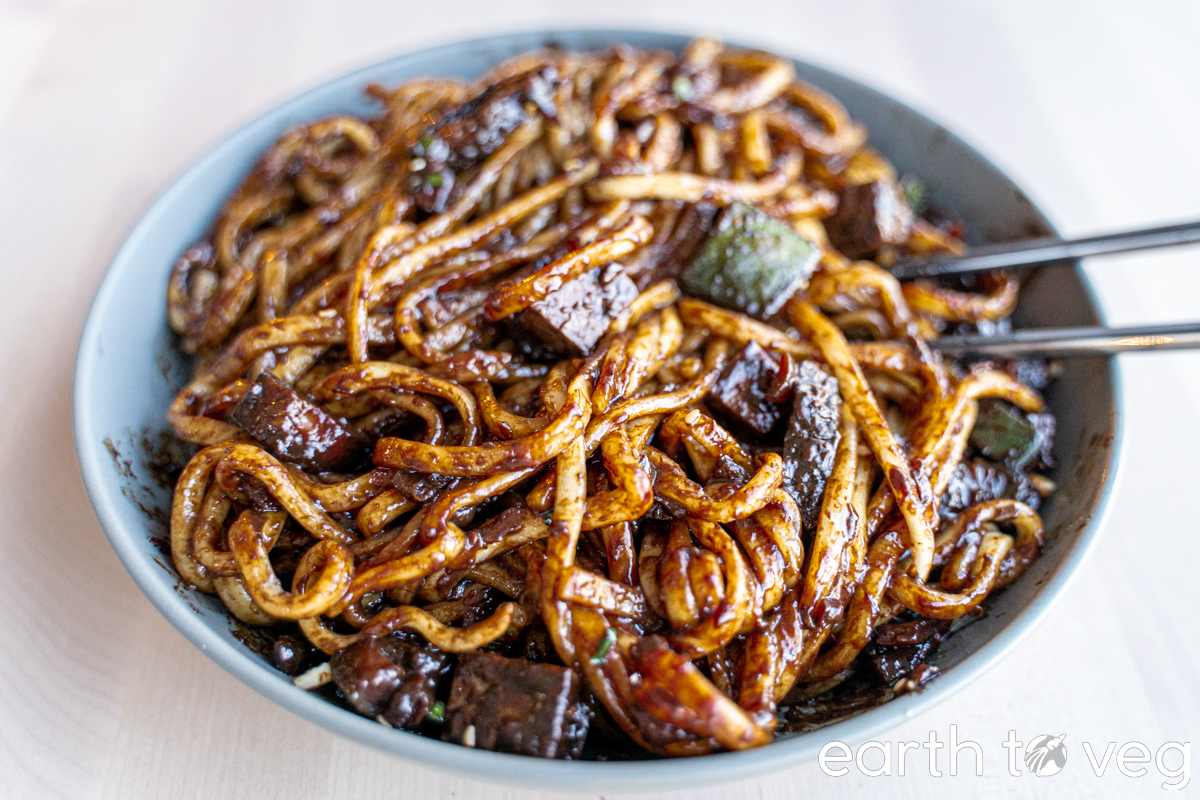
Rice option: Cook 3/4 cup or 150g of dried rice using your preferred method (I prefer Stovetop Rice). Mix with jjajang sauce.
If you want to be exxxtra gourmet, add a julienned cucumber and sesame seeds as topping.
What to Serve with Vegan Jajangmyeon
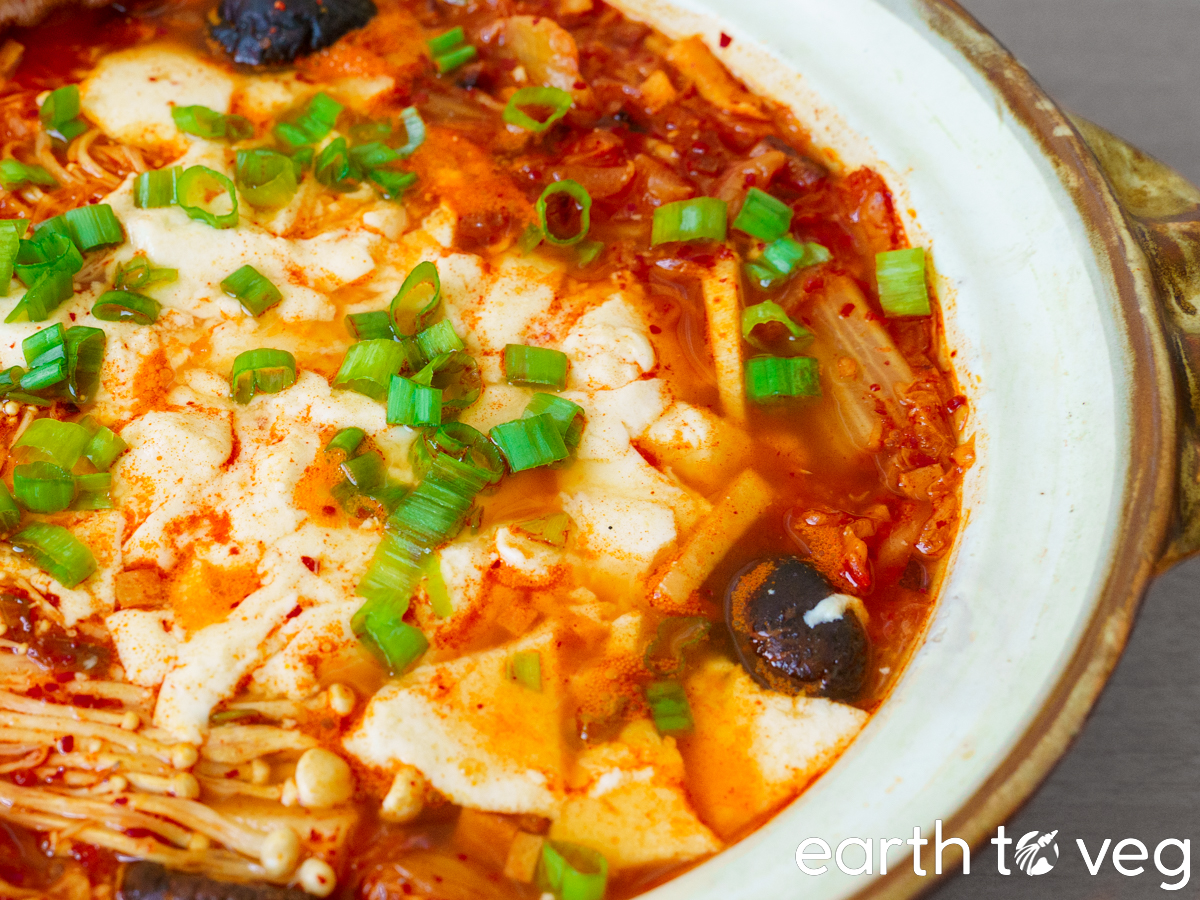
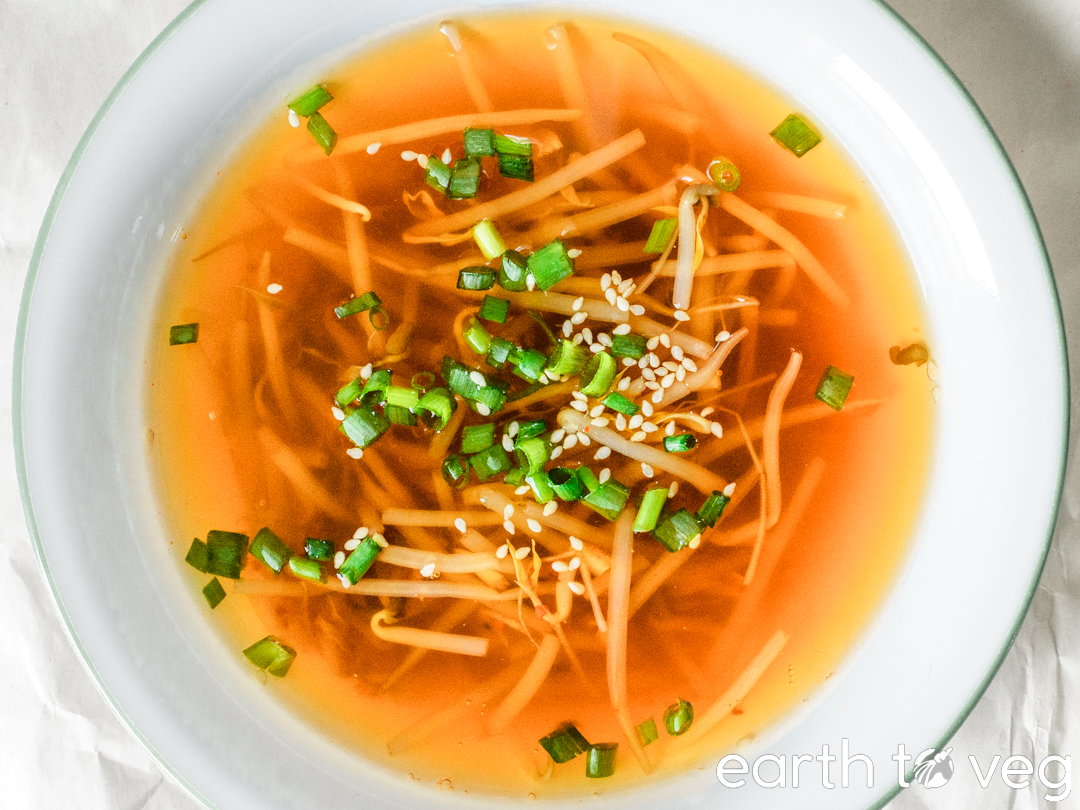
Make Ahead & Storage Tips
Make Ahead: Jjajang sauce can be made ahead of time as it reheats well. For best results, boil the noodles fresh right before you want to serve them. Then drain the noodles and toss together with jjajang sauce, and that should be enough to warm up the sauce.
Fridge: I recommend storing the sauce and noodles separately to prevent the noodles from absorbing too much sauce and getting soggy. Jjajang sauce and noodles can be kept in the fridge for up to 5 days.

If you must cook the noodles beforehand, toss them in a little oil to prevent them from sticking together while refrigerated.
Recipe FAQs
Yes, Korean black bean noodles, also known as jjajangmyeon noodles, can be vegetarian. However, it depends on the recipe you choose. Many restaurant versions of black bean noodles contain meat such as pork. As long as meat is omitted, jajangmyeon is usually vegetarian as the sauce and seasoning ingredients are all vegan.
If you’re looking for a substitute for pork in jajangmyeon, there are several options you can consider:
Tofu: Firm or fried tofu can be a suitable substitute for pork in jajangmyeon. Cut the tofu into small cubes and stir-fry it along with the vegetables and black bean sauce. Tofu can provide a similar texture and absorb the flavors of the sauce.
Mushrooms: Dried shiitake mushrooms, add a meaty texture and umami flavor to your Jajangmyeon. Slice or dice the mushrooms and cook them until they are tender and well-seasoned.
Seitan: Seitan, also known as wheat gluten, is a plant-based protein source with a chewy and meat-like texture. You can pan-fry or stir-fry sliced seitan to substitute for pork in Jajangmyeon.
Vegan pork belly: In some Asian groceries you can find imitation pork belly made from plant-based ingredients. They can be diced up and sautéed just like real pork.
Here are a couple alternatives to jajang noodles that you can consider:
Udon: Udon noodles are thick and chewy, which can provide a satisfying texture similar to Jajangmyeon noodles. They are commonly used in stir-fried dishes and can work well with the rich black bean sauce.
Linguine: In a pinch, fresh or dried linguine pasta can be used as a substitute as they have a similar shape and width. While they have a different texture compared to Jajangmyeon noodles, they can still absorb the flavors of the sauce and provide a satisfying base for the dish.
More Asian Stovetop Entrées
If you like, check out these other Asian stir fry entrées:
Recipe Card
Did you make this recipe? Please consider leaving a rating below to let me know how you liked it.
You can also take a picture and tag me on Instagram @earthtoveg, I will shout you out in my Stories!
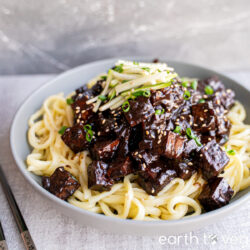
Vegan Jajangmyeon for Two (Korean Black Bean Noodles)
Use Imperial/Metric buttons below to toggle between volume vs weight measurements. I recommend weighing out your ingredients for best results.
Equipment
- Wok or sauté pan with high sides (this 3-quart sauté pan is a good size)
- Spatula
Ingredients
- 8oz fresh noodles see Note 1
- 1½ tbsp oil
- 1 small yellow onion, roughly chopped
- 8 oz fried tofu or firm tofu, sliced into 1/2-inch cubes see Note 2
- ½ cup zucchini, sliced into 1/2-inch cubes
- ½ cup daikon radish, sliced into 1/2-inch cubes see Note 3
- 6 dried shiitake mushrooms, soaked and sliced into strips see Note 4
- 5 tbsp chunjang paste I'm using Obok brand
- 1 tsp sugar
- ¼ tsp ground black pepper
- 1 cup water see Note 4
- ½ tbsp cornstarch *can sub with potato starch or tapioca starch
- 1 tsp sesame oil 4g
- salt to taste
Instructions
Jjajang Sauce
- Add 1 tbsp oil to a wok or sauté pan on medium heat (reserve the remaining 1/2 tbsp of oil for Step 3).
- Sauté the diced onions, tofu, zucchini, radish, and shiitake mushrooms on medium heat until soft and aromatic, around 10 minutes. Meanwhile, mix together 1 tsp sugar, 1/4 tsp black pepper, 1 cup cold water, and 1/2 tbsp cornstarch in a small cup and set aside.
- Use a spatula to create a small space in the center of the pan. Add the reserved 1/2 tbsp of oil followed immediately by 5 tbsp of chunjang paste. Gently fry the chunjang paste in the oil for about a minute, then mix it into everything else in the pan.
- Pour over the cornstarch-water mixture. Continue to cook until sauce has thickened to your liking—shouldn’t take more than a couple of minutes. You want it saucy enough to be able to luxuriously coat all the noodles. Drizzle with sesame oil and set aside.
Jjajangmyeon (Noodle option)
- Bring a pot of water to a boil then add 8oz (230g) of fresh noodles or 6oz (170g) of dried noodles. Cook for the recommended time on the package, then portion into plates. Top with the jjajang sauce.
Jjajangbap (Rice option)
- Cook 3/4 cup (150g) of dried rice using your preferred method (I like Stovetop Rice). Mix with jjajang sauce.
Video
Notes
- Noodle: You can also use fresh udon noodles or pasta (I recommend linguine or fettucine). In place of fresh noodles, you can use 6oz / 170g of dried noodles. If using dried noodles, increase water to 1½ cups and simmer for 8 minutes instead of 2.
- Tofu: You can use any kind of firm tofu that holds up to stir-frying and braising. I have tried this recipe with stew-style fried tofu, smoked tofu, plain extra-firm tofu, and pressed bean curd. My favourite pick is unseasoned fried tofu as it has the most satisfying texture and really soaks up the flavours of the jjajang sauce!
- Radish: Daikon radish has quite a strong taste and smell. It can be substituted with potatoes for a milder sauce.
- Mushrooms: Small dried shiitake mushrooms will take 6 hours to rehydrate in room temperature water. Or you can use boiling hot water, which cuts the soak time down by half. Save 1 cup of the soaking water for use later on in this recipe.

I’ve tried a couple different recipes for jjm, and this one is by far the best! Easy process and flavourful end result.